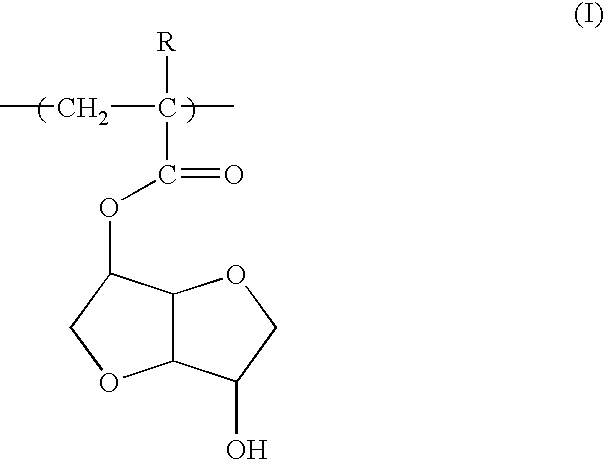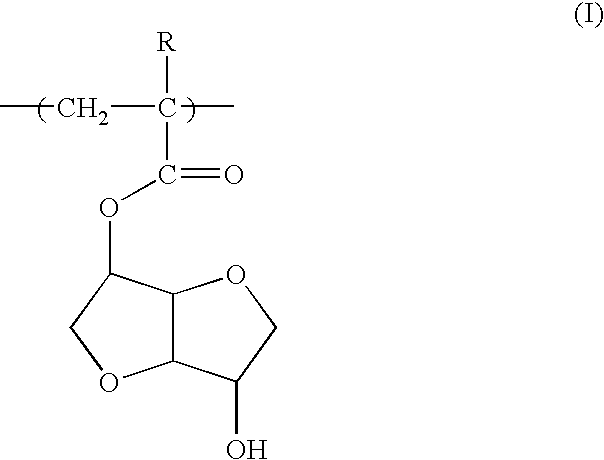Photoresist polymeric compound and photoresist resin composition
a polymeric compound and resin technology, applied in the direction of auxillary/base layers of photosensitive materials, instruments, photosensitive materials, etc., to achieve the effect of well-balanced solubility in solvents
- Summary
- Abstract
- Description
- Claims
- Application Information
AI Technical Summary
Benefits of technology
Problems solved by technology
Method used
Image
Examples
example 1
Synthesis of Resin Having the Following Structure
[0140]
[0141]In a round-bottom flask equipped with a reflux condenser, a stirring bar and a three-way stopcock, 20 g of propyleneglycol monomethylether acetate (PGMEA) was placed in a nitrogen atmosphere, while maintaining the temperature at 75° C. with stiring, and 18.41 g (82.9 mmole) of 5-methacryloyloxy-2,6-norbornanecarbolactone [compound number [2-6] (methacrylate)], 4.44 g (20.7mmole) of isosorbide methacrylate [a mixture of a compound number [1-1] (methacrylate) and a compound number [1-2] (methacrylate)], 27.16 g (103.6 mmole) of 1-(1-methacryloyloxy-1-methylethyl)adamantane [compound number [3-13] (methacrylate)], 6.0 g of dimethyl-2,2′-azobisisobutylate (initiator, “V-601” manufactured by WAKO JUNYAKU INDUSTRY) and 180 g of PGMEA were mixed and the obtained monomer solution was dropped at constant rate over 6 hours while stirring. After completion of dropping, the resulting mixture was stirred for more 2 hours. After the com...
example 2
Synthesis of Resin Having the Following Structure
[0142]
[0143]The procedure of Example 1 was repeated, except for using monomer components of 19.54 g (88.0 mmole) of 5-methacryloyloxy-2,6-norbornanecarbolactone [compound number [2-6] (methacrylate)], 4.71g (22.0mmole) of isosorbide methacrylate [mixture of a compound number [1-1] (methacrylate) and a compound number [1-2] (methacrylate)], 25.75 g (110.0 mmole) of 2-methacryloyloxy-2-methyladamantane [compound number [3-1] (methacrylate)], and then 44.7 g of the desired resin was obtained. The recovered polymer was subjected to GPC analysis to find that the polymer has a weight-average molecular weight (Mw) of 10100 and a molecular weight distribution (Mw / Mn) of 2.53.
example 3
Synthesis of Resin Having the Following Structure
[0144]
[0145]The procedure of Example 1 was repeated, except for using monomer components of 18.31 g (88.0 mmole) of 5-acryloyloxy-2,6-norbornanecarbolactone [compound number [2-6] (acrylate)], 4.40 g (22.0 mmole) of isosorbide acrylate [mixture of a compound number [1-1] (acrylate) and a compound number [1-2] (acrylate)], 27.29 g (110.0 mmole) of 1-(1-acryloyloxy-1-methylethyl)adamantane [compound number [3-13] (acrylate)] and then 43.8 g of the desired resin was obtained. The recovered polymer was subjected to GPC analysis to find that the polymer has a weight-average molecular weight (Mw) of 8700 and a molecular weight distribution (Mw / Mn) of 2.35.
PUM
| Property | Measurement | Unit |
|---|---|---|
| temperature | aaaaa | aaaaa |
| thickness | aaaaa | aaaaa |
| thickness | aaaaa | aaaaa |
Abstract
Description
Claims
Application Information
 Login to View More
Login to View More - R&D
- Intellectual Property
- Life Sciences
- Materials
- Tech Scout
- Unparalleled Data Quality
- Higher Quality Content
- 60% Fewer Hallucinations
Browse by: Latest US Patents, China's latest patents, Technical Efficacy Thesaurus, Application Domain, Technology Topic, Popular Technical Reports.
© 2025 PatSnap. All rights reserved.Legal|Privacy policy|Modern Slavery Act Transparency Statement|Sitemap|About US| Contact US: help@patsnap.com



